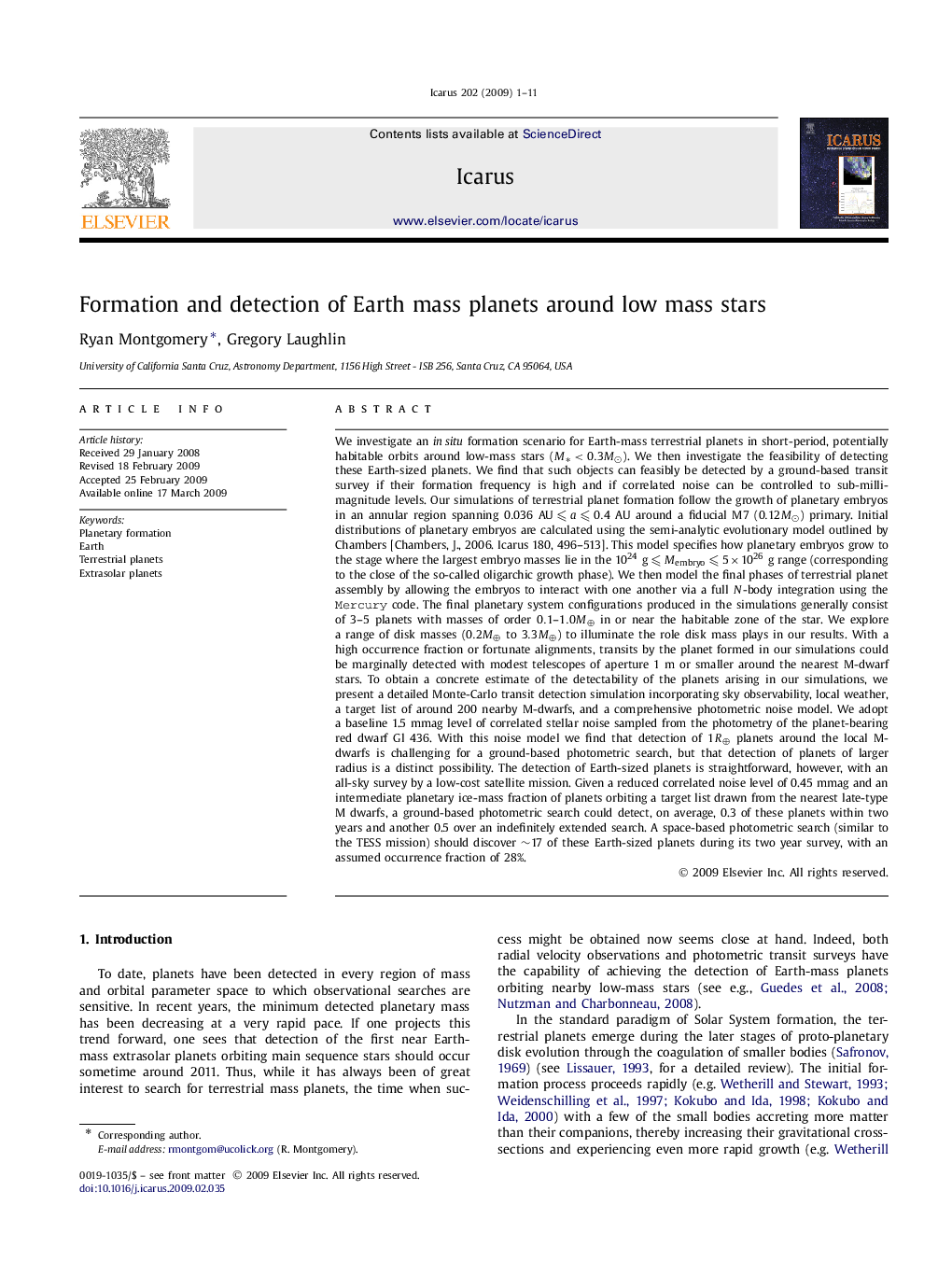| کد مقاله | کد نشریه | سال انتشار | مقاله انگلیسی | نسخه تمام متن |
|---|---|---|---|---|
| 1775094 | 1021184 | 2009 | 11 صفحه PDF | دانلود رایگان |

We investigate an in situ formation scenario for Earth-mass terrestrial planets in short-period, potentially habitable orbits around low-mass stars (M∗<0.3M⊙M∗<0.3M⊙). We then investigate the feasibility of detecting these Earth-sized planets. We find that such objects can feasibly be detected by a ground-based transit survey if their formation frequency is high and if correlated noise can be controlled to sub-milli-magnitude levels. Our simulations of terrestrial planet formation follow the growth of planetary embryos in an annular region spanning 0.036 AU⩽a⩽0.4 AU0.036 AU⩽a⩽0.4 AU around a fiducial M7 (0.12M⊙0.12M⊙) primary. Initial distributions of planetary embryos are calculated using the semi-analytic evolutionary model outlined by Chambers [Chambers, J., 2006. Icarus 180, 496–513]. This model specifies how planetary embryos grow to the stage where the largest embryo masses lie in the 1024 g⩽Membryo⩽5×1026 g1024 g⩽Membryo⩽5×1026 g range (corresponding to the close of the so-called oligarchic growth phase). We then model the final phases of terrestrial planet assembly by allowing the embryos to interact with one another via a full N-body integration using the Mercury code. The final planetary system configurations produced in the simulations generally consist of 3–5 planets with masses of order 0.1–1.0M⊕0.1–1.0M⊕ in or near the habitable zone of the star. We explore a range of disk masses (0.2M⊕0.2M⊕ to 3.3M⊕3.3M⊕) to illuminate the role disk mass plays in our results. With a high occurrence fraction or fortunate alignments, transits by the planet formed in our simulations could be marginally detected with modest telescopes of aperture 1 m or smaller around the nearest M-dwarf stars. To obtain a concrete estimate of the detectability of the planets arising in our simulations, we present a detailed Monte-Carlo transit detection simulation incorporating sky observability, local weather, a target list of around 200 nearby M-dwarfs, and a comprehensive photometric noise model. We adopt a baseline 1.5 mmag level of correlated stellar noise sampled from the photometry of the planet-bearing red dwarf Gl 436. With this noise model we find that detection of 1R⊕1R⊕ planets around the local M-dwarfs is challenging for a ground-based photometric search, but that detection of planets of larger radius is a distinct possibility. The detection of Earth-sized planets is straightforward, however, with an all-sky survey by a low-cost satellite mission. Given a reduced correlated noise level of 0.45 mmag and an intermediate planetary ice-mass fraction of planets orbiting a target list drawn from the nearest late-type M dwarfs, a ground-based photometric search could detect, on average, 0.3 of these planets within two years and another 0.5 over an indefinitely extended search. A space-based photometric search (similar to the TESS mission) should discover ∼17 of these Earth-sized planets during its two year survey, with an assumed occurrence fraction of 28%.
Journal: Icarus - Volume 202, Issue 1, July 2009, Pages 1–11